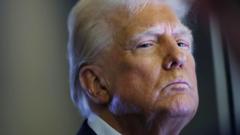As Donald Trump embarks on his second term, his recent actions reflect a confident and methodical approach reminiscent of an astute learner who has taken stock of past experiences. This past Saturday, while flying across the country from Las Vegas to Miami, Trump engaged in a 20-minute discussion with reporters aboard Air Force One. Seemingly buoyed by recent events, he expressed satisfaction with the achievements of his first week back in the office. “We’re getting A-pluses on the work done,” he announced, characterizing it as perhaps the most successful initiation a president has ever had.
This bold assertion came after a whirlwind of executive actions that reversed key policies initiated by his predecessor, Joe Biden. Trump has taken decisive steps—from a significant purge of independent watchdogs in government agencies to provocative declarations about foreign affairs, including ambitions regarding Greenland. The tone was set for a new presidency marked by assertive decision-making and a visible departure from political restraint.
Decorative changes in the Oval Office reflect this new era; iconic symbols from previous administrations are back in place, including the Diet Coke button and notable portraits, underscoring Trump’s bid to reclaim his influence. But more pertinent to his approach is the strategic mastery surrounding his administration, which, unlike his first term, appears more unified and resolute. Trump has filled key positions with long-time loyalists and fresh faces experienced in the Trumpian ethos, ensuring continuity in executing his agenda.
The presiding narrative surrounding the January Capitol riot has been reframed through Trump’s lens, with plans to pardon over 1,500 of his supporters involved in the incident, asserting his affiliation with them amidst wider public scrutiny. Additionally, changes such as the renaming of the Gulf of Mexico and withdrawal from global accords echo a desire to redefine national and international identity according to his vision.
Unlike the disorganized state of his first day in office back in 2017, Trump’s team now exhibits a more calculated strategy. Political historians remark that this readiness stems from four years of voluntary exile wherein the administration meticulously prepared for the possibility of returning to power. They anticipate a more effective implementation of policies, especially concerning immigration, where there are calls to rapidly mobilize troops and enforce strict measures at the border.
Despite potential judicial challenges that may arise against some of his orders, the strategic emphasis on speed and disruption signifies Trump’s relentless drive towards shaping an enduring legacy. With a Congress firmly in Republican hands for the time being, Trump is positioned to challenge the norms of governance like never before. As this chapter unfolds, his administration promises to be as unpredictable as it is ambitious, heralding a controversial yet anticipated new period in American politics.
This bold assertion came after a whirlwind of executive actions that reversed key policies initiated by his predecessor, Joe Biden. Trump has taken decisive steps—from a significant purge of independent watchdogs in government agencies to provocative declarations about foreign affairs, including ambitions regarding Greenland. The tone was set for a new presidency marked by assertive decision-making and a visible departure from political restraint.
Decorative changes in the Oval Office reflect this new era; iconic symbols from previous administrations are back in place, including the Diet Coke button and notable portraits, underscoring Trump’s bid to reclaim his influence. But more pertinent to his approach is the strategic mastery surrounding his administration, which, unlike his first term, appears more unified and resolute. Trump has filled key positions with long-time loyalists and fresh faces experienced in the Trumpian ethos, ensuring continuity in executing his agenda.
The presiding narrative surrounding the January Capitol riot has been reframed through Trump’s lens, with plans to pardon over 1,500 of his supporters involved in the incident, asserting his affiliation with them amidst wider public scrutiny. Additionally, changes such as the renaming of the Gulf of Mexico and withdrawal from global accords echo a desire to redefine national and international identity according to his vision.
Unlike the disorganized state of his first day in office back in 2017, Trump’s team now exhibits a more calculated strategy. Political historians remark that this readiness stems from four years of voluntary exile wherein the administration meticulously prepared for the possibility of returning to power. They anticipate a more effective implementation of policies, especially concerning immigration, where there are calls to rapidly mobilize troops and enforce strict measures at the border.
Despite potential judicial challenges that may arise against some of his orders, the strategic emphasis on speed and disruption signifies Trump’s relentless drive towards shaping an enduring legacy. With a Congress firmly in Republican hands for the time being, Trump is positioned to challenge the norms of governance like never before. As this chapter unfolds, his administration promises to be as unpredictable as it is ambitious, heralding a controversial yet anticipated new period in American politics.




















